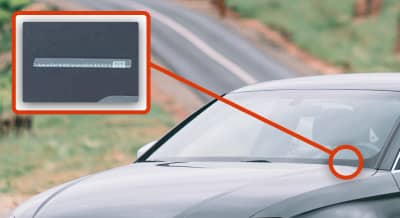| Window Sticker Availability for U.S. VINs | |
| Car Brands | Years Available |
| Alfa Romeo | 2015 – Current |
| Audi | 2019 – Current |
| BMW, Mini | 2018 (Midyear) – Current |
| Buick, Cadillac, Chevrolet, GMC | 1997 – Current |
| Chrysler, Dodge, Jeep | 2004 – Current |
| Fiat, Ram | 2012 – Current |
| Ford, Lincoln | 2011 – Current |
| Genesis | 2017 – Current |
| Geo | 1997 |
| HUMMER | 2003 – 2010, 2022 – Current |
| Hyundai | 2009 – Current |
| Kia | 2007 – Current |
| Lexus | 2010 – Current |
| Mazda | 2004 – Current |
| Mercury | 2011 |
| Nissan, Infiniti | 2001 – Current |
| Oldsmobile | 1997 – 2004 |
| Pontiac, Saturn | 1997 – 2010 |
| Porsche | 2015 – 2018 |
| Saab | 1997 – 2011 |
| Subaru | 2006 – Current |
| Toyota | 2001 – Current |
| Volvo | 2020 – Current |



Volvo Window Sticker by VIN
Buy a sticker to see your car's original equipment and price when it was new
It's fast, easy and free to check if there's a Volvo window sticker available. See other brands we cover.
How will the Volvo window sticker help me?
iSeeCars Window Stickers for new or used cars recreate the original Volvo window sticker, which includes the original MSRP, original mechanical specifications, color, standard equipment, optional equipment and pricing, and safety ratings and fuel economy ratings when they're available.
Get the Volvo window sticker to check for missing or inaccurate factory options – so you can confirm the vehicle's equipment and negotiate a fair deal whether you're buying or selling a vehicle.
What's in the Volvo Window Sticker?
|
Commonly referred to as a "Monroney label" or Volvo "Monroney window sticker," window stickers are a requirement for all new vehicles in the United States. The iSeeCars Volvo Window Sticker reproduces the original factory window sticker. The Volvo window sticker gives you info about the original new-car price and standard equipment, optional equipment and prices, engine and transmission specs, fuel economy and more. How To Get Your Volvo Window Sticker:Step 1: Check if the sticker is available by typing or copy and pasting the Volvo VIN in the iSeeCars Window Sticker Lookup Tool. Step 2: You'll be able to purchase it if the Volvo window sticker is available. Step 3: Fill out the information and you'll see your Volvo window sticker after checking out. |

|
How To Check for Volvo Window Stickers by VIN?

Get the Volvo VIN number
Usually you'll find the Volvo VIN on the interior of the car, on the dashboard above the steering wheel or inside the driver's door jamb, where the door connects to the vehicle.

Find a window sticker lookup tool
Depending on the age of the car, a window sticker lookup or VIN lookup tool is available from sources like the original selling dealer, automaker and consumer shopping sites.

Check the iSeeCars Window Sticker
Enter the car's VIN number in the iSeeCars Window Sticker Tool to confirm information is available about the car's equipment before printing or saving a digital copy of the window sticker
Window Sticker FAQs for New and Used Cars
Why do new cars have a window sticker?
A car's window sticker, also known as a "Monroney window sticker" or "Monroney Label," has been produced for every new car since 1958. That was the year Mike Monroney, a senator from Oklahoma, sponsored and passed a bill called the Automobile Information Disclosure Act of 1958, which required every new vehicle to display standard information about the vehicle. Senator Monroney had seen enough evidence of questionable automaker and car dealer pricing practices to want standardized window sticker information that consumers could rely on for all automotive purchases.
What information was included on a car's original window sticker in 1958?
The information that was originally required on a car's window sticker included these items:
- The vehicle's make, model and trim
- Vehicle description, including exterior and interior colors
- Serial number, also known as the VIN (Vehicle Identification Number)
- The Manufacturer's Suggested Retail Price (MSRP)
- Basic drivetrain specs (typically engine size and transmission gear count)
- Standard equipment included in the base model
- Optional equipment and its pricing
- Transportation and dealer prep costs, often referred to as the "destination charge"
- The car's total price (standard features plus optional upgrades plus destination charge) as it was originally equipped
- Warranty information
What information do today's window stickers include?
The required information on a new car's window sticker has evolved over time, with city and highway fuel economy ratings from the Environmental Protection Agency (EPA) added in the 1970s and crash test ratings from the National Highway Traffic Safety Administration (NHTSA) added in 2007.
Today's new car window stickers include the following:
- The information originally required in 1958
- EPA city and highway fuel economy ratings
- NHTSA crash test ratings
- Information on greenhouse gas emissions
- Estimated gallons of fuel needed to travel 100 miles; estimated kilowatt hours per 100 miles for battery electric vehicles (BEVs); and the miles per gallon gasoline equivalent (MPGe) for electric, plug-in hybrid (PHEV), flex-fuel, natural gas and hydrogen fuel cell vehicles
- Estimated annual and 5-year fuel (or electricity) costs
- A QR code that can be scanned with a smartphone to get updated information on fuel or electricity prices
Are window stickers available for used cars?
While an original window sticker is required for every new vehicle before it's sold, used cars, whether privately owned or sold through a car dealership, are not required to have one. This means used car shoppers have to either research all of the information on their own or buy a used car without confirmation of its drivetrain specifications, standard and optional equipment, fuel economy estimates and safety ratings.
But a Monroney sticker, or new car window sticker, can be reproduced for used cars by using the car's vehicle identification number (VIN). The VIN is unique to every car and it contains the information necessary to know what equipment a vehicle came with when new. This means the car's original color, engine, transmission, standard and optional equipment, and fuel efficiency ratings when it was new, can be confirmed with a VIN decoder.
How does a window sticker help used car buyers and sellers?
During the used car buying process, a window sticker can verify what equipment a car had when it was new. If a car has been modified after it was sold new, the window sticker will make it easier to identify those changes. The window sticker can also help potential buyers understand what kind of fuel economy or electric range a used car will deliver, and how much it will cost to operate.
For car owners looking to sell their vehicle, having a window sticker can improve the confidence of potential buyers by letting them know exactly how the car was originally equipped. It can be a valuable piece of documentation combined with a vehicle history or CARFAX report and maintenance records.
What car brands and years does the iSeeCars Window Sticker By VIN cover?







